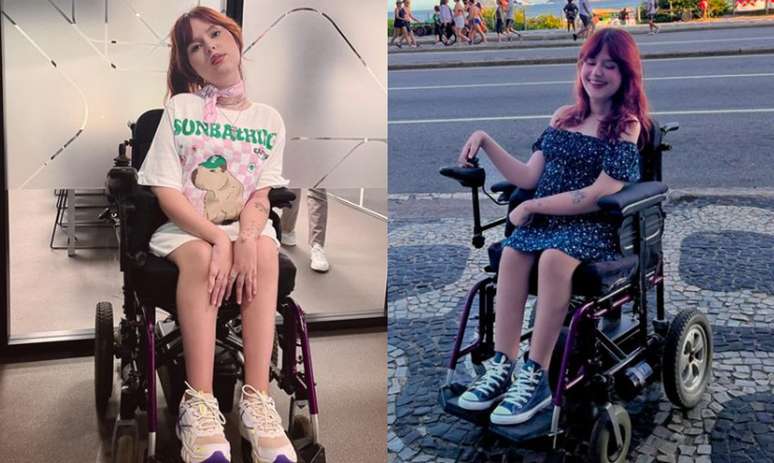Influencer Marina Melo Uses Social Media to Demystify AME and the Lives of People with Disabilities
Marina Melo’s family didn’t understand why, as a child, she could never sit still. The little girl would always fall on her side and make no effort to get up. But at eight months old, everyone had the answer: Marina was diagnosed with spinal muscular atrophy, also known as SMA.
Today the young woman is 20 years old and a digital influencer. Through social media she shares her vision of the world as a person with a disability. In this sense, trying to defend inclusion and accessibility, as well as going against ableism.
Spinal Muscular Atrophy: What is SMA?
SMA is a rare, degenerative, genetic disease. The condition interferes with the body’s ability to produce a protein essential to the survival of motor neurons, which are responsible for simple, vital voluntary actions of the body, such as breathing, swallowing, and movement.
As a result, from a certain point in life, the individual gradually loses the ability to move the muscles in his or her body, explains Alexandra Prufer de Queiroz Campos Araujo, a neuropediatrician and researcher at the Neuromuscular Diseases Research Center of the IPPMG-UFRJ.
The evolution of the disease depends on each case. The progression is usually extremely rapid (a matter of weeks) when the first symptoms appear in the first months of life. However, when the first symptoms appear between 6 and 18 months of age, it may take several months to notice the worsening.
Finally, the disease may progress more slowly, taking years to worsen, the doctor explains. This usually occurs in cases diagnosed after 18 months.
Symptoms
According to the neuropediatrician, the first symptoms of SMA are weakness in the legs. “When the onset occurs in the first months of life, in addition to the initial weakness of the legs, the child is soft (like a rag doll), although attentive to everything that happens around him. In addition, he has more visible breathing in the belly than in the chest and there is a “tremor” of the tongue”, explains Alexandra.
Without treatment, these babies are never able to hold their head up or even sit up and may die very soon. When the onset occurs after 6 months, babies are able to sit up, but have difficulty crawling, standing, and walking. They are also never able to walk without support if not treated in time.
“If the symptoms begin after the acquisition of walking, frequent falls, difficulty running, jumping, going up and down stairs are initially observed,” adds the specialist.
Diagnosis and Treatment of SMA
The diagnosis of the disease can be made at the appearance of the first symptoms, confirming the suspicion through genetic testing, if the neurological examination shows signs of damage to the second motor neuron. In addition, the diagnosis can also be made through genetic testing at birth (if included in the neonatal screening program), specifies the doctor.
The treatment involves a multidisciplinary team and the use of drugs that “stimulate” the body to produce the protein that is lacking due to the genetic alteration. Alexandra recalls that in Brazil, 3 drugs have been approved for registration: gene therapy (only usable in newborns), oral therapy and intrathecal injection therapy.
“The latter two are included in the Clinical Protocol of the Therapeutic Guidelines, for use in SUS for patients affected by AME5q (mutation of the SMN1 gene located on chromosome 5q) type 1 and 2 (onset in the first months or onset between 6 and 18 years) months) who do not depend on continuous ventilatory support”, says the doctor.
Living with the disease
Marina has AME II (muscle weakness). According to the Ministry of Health, SMA is divided into five types: 0, 1, 2, 3, and 4. Type 1 is the most common and most severe form of the disease.
One of the biggest daily challenges is accessibility. Despite this, she feels she currently has a lot of autonomy. The young woman says she still needs help to sit, wash herself and do other activities, but she has enough autonomy to do everything she wants or needs. “I just need someone who is willing to help me, so when I want something, I talk and teach the person how to do it,” she says.
Marina received the indication to start treatment with Risdiplam, which required a long process, as the medicine is offered by the SUS in specific cases, different from the one she presented.
According to the influencer, it would be impossible to pay for the treatment, since each box of medicine is worth R$ 70,000 if purchased individually. “You know when you feel something so strong that you can’t even put it into words? A mixture of relief, happiness and fear: that’s how I felt when I started the process, on December 20, 2022,” he says.
Today, her goal is to demystify AME and other disabilities. “Society believes that people with disabilities cannot lead an ordinary life or form bonds and maintain relationships, but that is pure ableism. We live an ordinary life, as much as we can. And because of a lack of inclusive policies or a society becoming more inclusive, we fail to do some things, but it is essential to understand that people with disabilities can do everything. Our disability does not define who we are, it is just another characteristic,” she emphasizes.
Source: Terra
Ben Stock is a lifestyle journalist and author at Gossipify. He writes about topics such as health, wellness, travel, food and home decor. He provides practical advice and inspiration to improve well-being, keeps readers up to date with latest lifestyle news and trends, known for his engaging writing style, in-depth analysis and unique perspectives.








